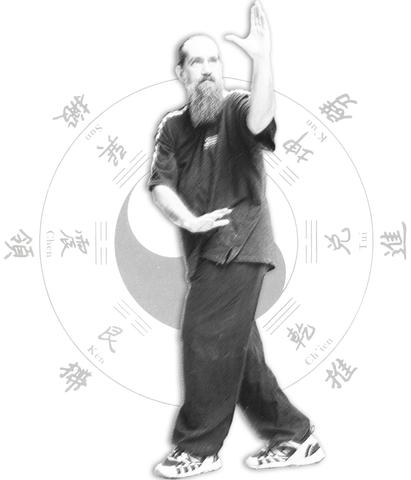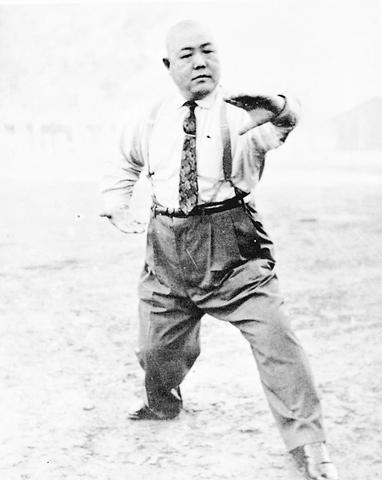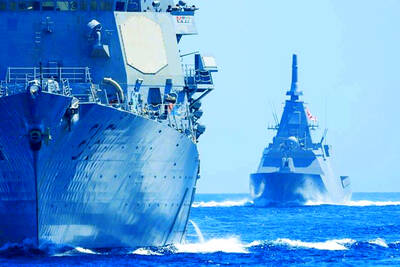The master and his student sat privately in the master's study. The master spoke, saying, "my student, you must flee to the outlying island. The new regime is certain of victory and with their victory will come a time where our religion and our martial art will be suppressed. To ensure the survival of the martial arts I have passed on to you, I want you to leave this land and journey to the island. There, hopefully, the art I have transmitted to you will be preserved from the coming darkness."
Sounds like a kung fu novel or maybe a plot to a Star Wars movie? It was an actual event. The martial arts master was Zhang Zhao-dong (
At the end of the Chinese Civil War, Taiwan became an important repository and conservatory of many aspects of Chinese culture such as painting, calligraphy, opera and traditional martial arts. In particular, Taiwan provided a refuge for practitioners of the three internal martial arts of tai chi chuan (太極拳), hsing yi chuan (形意拳) and pa kua chang (八卦掌).

Wang Shu-chin (1905-1981) was one of many martial arts masters who sought refuge in Taiwan following the Chinese Civil War. Over the years, the three internal martial arts that he brought with him have taken firm root in Taiwan and even expanded further to the US, Australia and beyond.
The internal martial arts that Wang Shu-chin practiced, tai chi, hsing yi and pa kua have a number of characteristics that link them together. They are each based in Taoist philosophy and emphasize the development and use of chi (氣), which is the term used in traditional Chinese medicine for the life force. The three internal martial arts seek to enhance the practitioner's overall mental, physical and spiritual state. These three martial arts can perhaps best be described as forms of moving meditation that, by their practice, give rise to martial ability.
Chi is central to the internal martial arts. It has been defined many ways and is an important part of many traditional Chinese arts. It is also an intrinsic part of traditional Chinese medicine. Scholars generally define it as the force or energy that animates all living things -- a kind of "elan vital." Chi has been likened to a flow of fluid or of electricity through the practitioner's body. Control and use of this energy is the goal of each of the three arts Wang brought to Taiwan.

PHOTO COURTESY OF THE CHINESE MARTIAL ARTS LIBRARY
These arts are referred to as "internal" because their training methods place an emphasis on the practitioner "looking inside" themselves and studying how their mind interacts with physical movements through breath and chi. Along with this is an emphasis on how their mind, breath and chi work together to create a very healthy, integrated individual.
But the arts are also extremely effective in combat, as revealed in many stories involving Wang Shu-chin. The source for most of the historical information about Wang is his student, Wang Fu-lai (
According to him, Wang Shu-chin was born in 1904 as the sixth son in a family of farmers living in a village about 32km from Tianjin City in northern China. His older brothers were content to farm, but Wang wanted to be part of a bigger world. So, with his parent's permission, he left home when he was 14 years old and traveled to Tianjin seeking fame and fortune. There he found work as an apprentice in an international trading company.
By the time of his arrival in Tianjin, Wang was already, as his student Wang Fu-lai puts it, "a man of impressive size and unusual physical strength." He was also very interested in martial arts and religion and began to search for martial arts instruction. By chance one day, a senior student of the famous martial arts master Zhang Zhao-dong came to the business where Wang worked. This chance meeting led to the then 18-year-old Wang studying under Zhang.
Under Zhang's instruction, Wang learned the two arts for which he would later become famous; pa kua chang and hsing yi chuan. Pa kua chang means "eight diagram palms" and refers to the eight core diagrams which make up the I-Ching (
The practice of pa kua chang consists of moving around in a circle while performing eight different martial arts techniques which use the palms to strike an opponent. Each of these eight techniques corresponds to one of the eight fundamental diagrams in the I-Ching. Maneuvering around to the side or back of the opponent, a practitioner strikes using one of the eight techniques. The art also emphasizes throwing the opponent -- much like in judo -- as well as various arm locks.
Wang could perform pa kua chang with dizzying speed, rapidly turning back and forth around the circle. Despite his size, he was able to move with incredible speed and agility, which he attributed to his study of the art form.
While pa kua focuses on circles, its sister art, hsing yi focuses on lines and linear attacks. Hsing yi consists of a set of five forms performed up and down along a straight line. These five forms correspond with the five elements in traditional Chinese philosophy: earth, water, fire, wood and metal. A hsing yi practitioner meets their opponent's attack on an oblique angle then overwhelms them with a series of rapid punches. The art, like pa kua, puts an emphasis on the use of chi and the integration of the whole body into a coordinated unit.
Hsing yi also trains its practitioners to be able to withstand the force of an opponent's blow. Wang was famous for his ability to withstand blows to any part of his body, excluding his head and groin. His "iron body" drew considerable interest from practitioners both in Taiwan and abroad.
In 1949, Wang's teachers sent him to Taiwan. They surmised -- correctly, history would prove -- that the change in China's government would likely lead to a suppression of martial arts. In order to ensure the survival of pa kua chang and hsing yi, Wang took them for safekeeping to Taiwan. He arrived in a fishing village in northern Taiwan in late 1949 and started his own rice business.
He also began to teach his martial arts and quickly gathered around him a number of dedicated students. Several years later he moved south to Taipei to open a rice shop. There Wang's businesses thrived and he became a fairly wealthy man.
He was also a man in demand. Word of his skill in martial arts spread and many wealthy people and politicians sought out Wang's instruction. While he considered his prominence flattering, given the political intrigues of the time, it was also dangerous. Distancing himself from this, Wang moved south to Taichung in 1952.
He continued to teach martial arts in Taichung where his reputation as a skilled hsing yi and pa kua practitioner preceded him. As number of established martial artists in the south of Taiwan sought to "test" Wang's abilities. Challenge matches in those days could be very rough affairs where the result was sometimes death. Wang successfully met all challengers and so cemented his reputation as Taiwan's most skilled hsing yi and pa kua fighter. Wang became known within Taiwanese martial arts circles as "the unvanquished."
His teaching too remains unvanquished. The martial arts association he formed in Taichung still teaches Wang's martial arts as he had. The association is now headed by Wang Fu-lai, who began studying under Wang at the age of 15.
After several years, Wang Fu-lai became the elder Wang's only personal student, meaning that he was permitted to live in Wang's house and be by Wang's side at all times. Today, the Cheng Ming Martial Arts Association is active not only in Taiwan, but in Argentina, Israel, the US, Japan and Australia.
This worldwide spread of the arts is evidence that Wang Shu-chin fulfilled his mission of preserving and spreading the martial arts that he had been entrusted with by his masters.

It’s always a pleasure to see something one has long advocated slowly become reality. The late August visit of a delegation to the Philippines led by Deputy Minister of Agriculture Huang Chao-ching (黃昭欽), Chair of Chinese International Economic Cooperation Association Joseph Lyu (呂桔誠) and US-Taiwan Business Council vice president, Lotta Danielsson, was yet another example of how the two nations are drawing closer together. The security threat from the People’s Republic of China (PRC), along with their complementary economies, is finally fostering growth in ties. Interestingly, officials from both sides often refer to a shared Austronesian heritage when arguing for

The ultimate goal of the Chinese Communist Party (CCP) is the total and overwhelming domination of everything within the sphere of what it considers China and deems as theirs. All decision-making by the CCP must be understood through that lens. Any decision made is to entrench — or ideally expand that power. They are fiercely hostile to anything that weakens or compromises their control of “China.” By design, they will stop at nothing to ensure that there is no distinction between the CCP and the Chinese nation, people, culture, civilization, religion, economy, property, military or government — they are all subsidiary

Nov.10 to Nov.16 As he moved a large stone that had fallen from a truck near his field, 65-year-old Lin Yuan (林淵) felt a sudden urge. He fetched his tools and began to carve. The recently retired farmer had been feeling restless after a lifetime of hard labor in Yuchi Township (魚池), Nantou County. His first piece, Stone Fairy Maiden (石仙姑), completed in 1977, was reportedly a representation of his late wife. This version of how Lin began his late-life art career is recorded in Nantou County historian Teng Hsiang-yang’s (鄧相揚) 2009 biography of him. His expressive work eventually caught the attention

Late last month the Executive Yuan approved a proposal from the Ministry of Labor to allow the hospitality industry to recruit mid-level migrant workers. The industry, surveys said, was short 6,600 laborers. In reality, it is already heavily using illegal foreign workers — foreign wives of foreign residents who cannot work, runaways and illegally moonlighting factory workers. The proposal thus merely legalizes what already exists. The government could generate a similar legal labor supply simply by legalizing moonlighting and permitting spouses of legal residents to work legally on their current visa. But after 30 years of advocating for that reform,